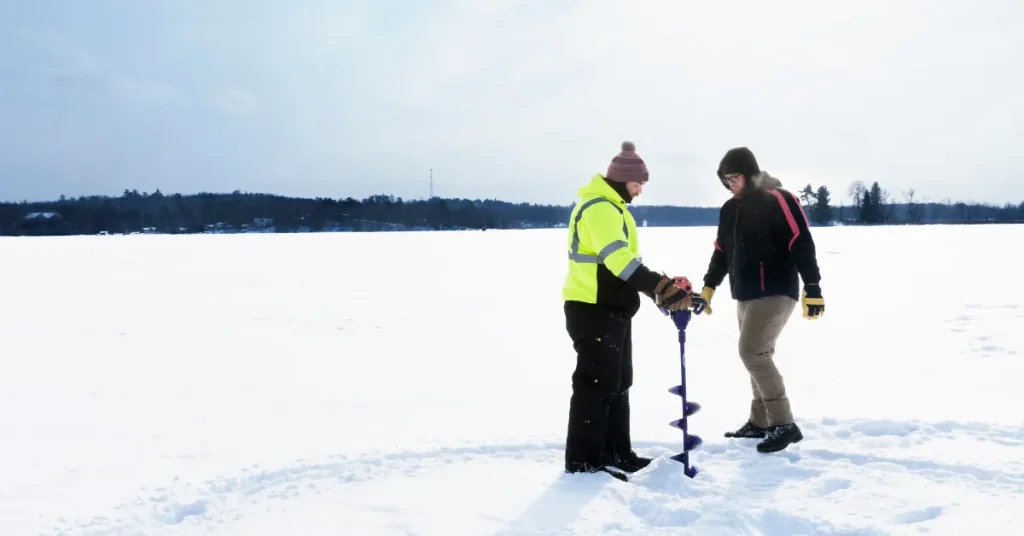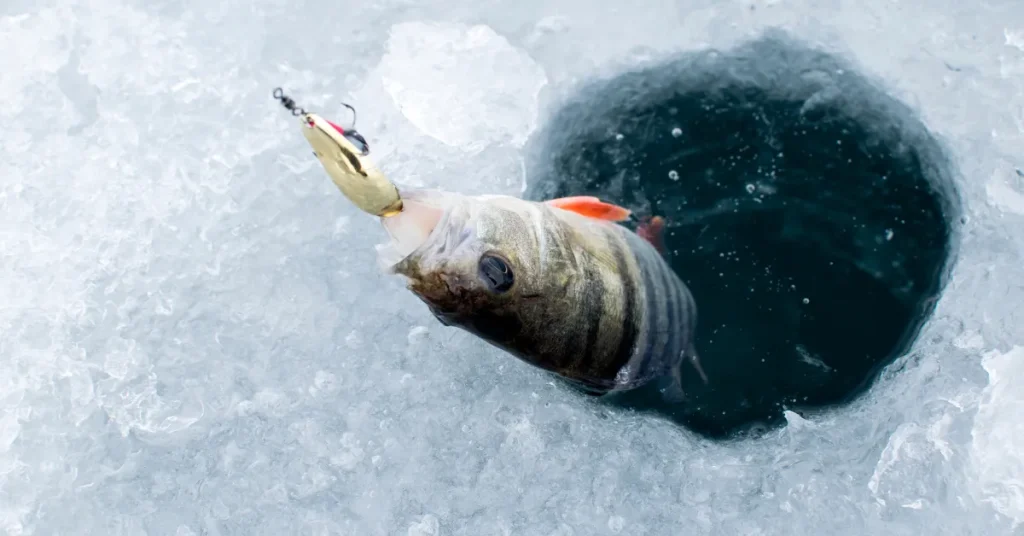Ice should be at least 4 inches thick for ice fishing. This thickness supports an individual’s weight safely.
Engaging in ice fishing requires not only skill and patience but also a keen eye for safety. Ice thickness is a critical factor that dictates the conditions under which anglers can venture onto frozen lakes or ponds.
Ice anglers should always prioritize confirming the ice’s solidity before settling in for a day of fishing.
To ensure a safe and enjoyable experience, they must measure the ice periodically, as thickness can vary across a single body of water.
Understanding this principle safeguards against the dangers of falling through thin ice, which could lead to severe consequences.
Guaranteeing a minimum of 4 inches of solid ice provides a basic safety margin for lone ice fishers looking to reel in their catch from the wintery depths.

Ensuring Safety On The Ice
The thrill of ice fishing begins with solid, safe ice. The goal is simple: return from the fishing trip with a catch, not a cold dunk in icy waters. Ensuring safety on the ice is crucial, and requires both preparation and knowledge about the ice conditions.
Preparation Tips For Ice Fishing
Proper preparation is the key to a successful and safe ice fishing experience.
- Check weather reports: Weather conditions can affect ice strength.
- Inform someone: Always tell a friend or family member where you’ll be.
- Pack safety gear:
- Ice picks
- Life vest
- Whistle
- Dress in layers: Stay warm with thermal wear and waterproof outerwear.
- Bring a buddy: Never ice fish alone. Two are safer than one.
Assessing Ice Conditions Before Fishing
Prior to setting foot on ice, gauge its safety to prevent dangerous situations.
| Ice Thickness | Permissible Load |
| 2″ or less | Stay off |
| 4″ | Safe for walking, solo fishing |
| 5″-7″ | Allows for a snowmobile or ATV |
| 8″-12″ | Supports a small car or group fishing |
| 12″-15″ | Holds a medium truck |
Use an ice chisel, auger, or ice drill to check thickness. Watch for clear, solid ice. White ice or “snow ice” is only half as strong. Watch for cracks, holes, or areas with flowing water. They are signs to avoid.
Measuring Ice Thickness

Measuring Ice Thickness is crucial for safe ice fishing. Knowing the exact thickness can mean the difference between a fun day out and a dangerous situation.
Ice must support not only your weight but also any gear you bring along. Before venturing out, learn how to measure the ice properly.
Tools For Checking Ice Depth
Choosing the right tools is the first step in ice measurement. The following tools can help ensure accurate readings:
- Ice Auger – Drills through the ice to create an access point for measurement.
- Tape Measure – Determines the depth of the ice at the drilled hole.
- Ice Scoop – Removes slush and ice chips from the hole for a clear view.
- Ice Chisel – Breaks through thin ice, providing a quick thickness estimate.
- Ice Claws – For safety, helps pull you out if the ice breaks.
Methodology For Accurate Measurements
To measure ice thickness accurately, follow this methodology:
- Check Local Guidelines – Refer to safety recommendations for minimum ice thickness.
- Select a Safe Area – Choose a spot away from visible cracks or flowing water.
- Drill a Hole – Use the ice auger to create an opening in the ice.
- Clear the Hole – Use the ice scoop to remove debris.
- Measure – Lower the tape measure down until it touches the water below. Then note the reading at the surface level.
- Verify – Repeat this process in several different locations to ensure consistency.
Ice Thickness Guidelines
When heading out for ice fishing, safety always comes first. Knowing the ice thickness guidelines could be the difference between a fun day and a dangerous situation.
The ice must be strong enough to hold a person, gear, and possibly a small shelter. It’s important to understand the minimum required thickness and the factors that influence ice strength.
Minimum Safe Ice Thickness For Fishing
Ice fishing requires caution and knowledge. The minimum safe ice thickness for an individual to walk on is around 4 inches. For groups spreading out, aim for at least 5 inches of clear, solid ice.
When bringing light vehicles, such as snowmobiles, onto ice, it should be 8-12 inches thick. For heavier vehicles, ice thickness should be at least 12-15 inches. Below is an ice thickness chart that serves as a quick reference:
| Activity | Minimum Ice Thickness |
| Walking single file | 4 inches |
| Group on foot | 5 inches |
| Snowmobile or ATV | 8-12 inches |
| Small Pickup | 12-15 inches |
Understanding Variations In Ice Strength
Not all ice is created equal. Ice strength can vary because of several factors. Temperature fluctuations, water currents, and sunlight can weaken ice. For instance, ice near the shore may be thinner due to warmer water.
Use tools like spuds or augers to constantly check ice thickness. Be mindful of ice color; clear blue ice is strongest, while white or opaque ice is weaker and requires more thickness to be safe. Always avoid ice with cracks, breaks, or holes.
- Temperature changes can rapidly alter ice thickness.
- Currents below the ice can erode it from beneath.
- External factors such as wind or rain can affect ice integrity.
Bear in mind that snow on ice can insulate and prevent freezing, thus reducing ice strength. Always assess ice safety before venturing out for ice fishing.
Risk Factors Impacting Ice Safety

Before venturing out for ice fishing, it’s crucial to understand the risks. Ice thickness isn’t consistent. It can vary due to multiple factors. Knowledge of these dangers helps prevent accidents.
Effects Of Weather On Ice Integrity
Weather plays a significant role in ice safety. Fluctuating temperatures cause ice to expand and contract. This weakens the ice structure. Warm spells followed by freezing can create a false sense of security. Ice may look solid but actually be very thin.
- Snow on ice acts like an insulator. It slows down the freezing process.
- Strong winds can break and shift ice, making it unpredictable.
- Rain can erode ice quickly.
- Quick temperature drops can cause stress fractures.
Always check the local weather before planning your trip. Be prepared for sudden changes.
Recognizing Dangerous Areas On A Frozen Body Of Water
Not all ice is safe, regardless of thickness. There are telltale signs you’re in a dangerous area. Avoid these at all costs.
| Danger Sign | Action |
| Cracks or Fissures | Keep away. These are weak points. |
| Water near Ice Edges | Do not approach. The ice is melting. |
| Dark Spots | Steer clear. This indicates thin ice. |
| Slushy Areas | Avoid walking. Ice strength is compromised. |
| Objects in Ice | Be cautious. Objects can heat ice and create weaknesses. |
Loud cracks or booms are a warning sign. If you hear them, leave the ice immediately.
Always fish with a buddy and carry safety gear. Tell someone your plan. Enjoy ice fishing with caution and respect for the ice.
Emergency Protocols And Gear
Understanding the right ice thickness is crucial for a safe ice fishing experience. While you may have checked the ice before venturing out, emergencies can occur.
Proper protocols and gear are your lifelines in such situations. Ensure you’re fully prepared to handle any unforeseen events on the ice.
Essential Safety Equipment For Ice Anglers
Before stepping out on the ice, make sure you have these safety items:
- Ice picks – Keep them around your neck for easy access.
- Throw rope – Essential for rescuing others or self-rescue.
- Life vest – Wear it beneath your winter gear for buoyancy.
- Ice cleats or spikes – For secure footing on slippery surfaces.
- Whistle – Sound it for attracting attention in emergencies.
- Personal floatation device (PFD) – It could save your life.
Steps To Take If Ice Breaks
If you fall through the ice, follow these immediate steps:
- Don’t panic. Stay as calm as possible.
- Call for help. Use your whistle or shout.
- Turn towards the direction you came from.
- Place hands and arms on unbroken ice.
- Kick your feet to propel yourself horizontally.
- Use ice picks to pull yourself onto solid ice.
- Roll away from the break until on stable ice.
- Keep your body flat, distributing weight evenly.
- Seek warmth and medical attention immediately.
Always fish with a buddy. Share your plans with someone before heading out. Remain vigilant and prepared to ensure your ice fishing trip is both fun and safe.
FAQs Thick Should Ice Be For Ice Fishing
How Much Weight Can 7 Inches Of Ice Hold?
Seven inches of ice can typically support about 1,200 pounds, suitable for small groups or a snowmobile. Always check local ice safety guidelines before venturing out, as conditions vary.
How Thick Does Ice Need To Be For Ice Fishing?
For safe ice fishing, ice thickness should be at least 4 inches for an individual and roughly 7 to 12 inches for group settings.
Is Ice Thicker In The Middle Of A Lake?
Ice thickness can vary, but it’s often thicker in the middle of a lake due to reduced edge exposure to warming elements.
How Much Ice Thickness Of 4 Inches Allows?
An ice thickness of 4 inches is generally considered safe for one person to walk or fish on. Always verify local conditions before venturing onto ice.
Conclusion
As we wrap up, remember the golden rule: ice needs to hold twice your weight. Generally, 4 inches is the minimum for safety, but aiming for thicker ice is wise.
Before setting out, always check local guidelines and updates. Your ice fishing adventure depends on preparation and caution.
Stay safe and enjoy the catch!
Resources:
1. https://idfg.idaho.gov/press/heres-where-go-ice-fishing-winter-and-why-you-should-do-it
